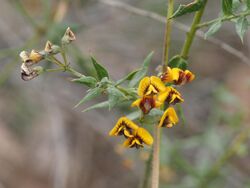Biology:Daviesia umbellulata
| Daviesia umbellulata | |
|---|---|

| |
| Near Corindi | |
| Scientific classification | |
| Kingdom: | Plantae |
| Clade: | Tracheophytes |
| Clade: | Angiosperms |
| Clade: | Eudicots |
| Clade: | Rosids |
| Order: | Fabales |
| Family: | Fabaceae |
| Subfamily: | Faboideae |
| Genus: | Daviesia |
| Species: | D. umbellulata
|
| Binomial name | |
| Daviesia umbellulata Sm.[1]
| |
Daviesia umbellulata is a species of flowering plant in the family Fabaceae and is endemic to eastern Australia. It is a slender shrub with egg-shaped or linear phyllodes, and groups of up to six yellow to orange flowers with maroon markings.
Description
Daviesia umbellulata is a slender shrub that typically grows to a height of 0.3–1 m (1 ft 0 in–3 ft 3 in) and has ribbed branchlets. The phyllodes are egg-shaped to linear, sometimes with a heart-shaped base, 7–30 mm (0.28–1.18 in) long and 0.5–8 mm (0.020–0.315 in) wide with a sharply-pointed tip. The flowers are arranged in groups of three to six, the groups on a peduncle 3–50 mm (0.12–1.97 in) long, the individual flowers on pedicels 4–5.5 mm (0.16–0.22 in) long. The five sepals are 3.0–3.5 mm (0.12–0.14 in) long and joined at the base, the upper two joined in a single "lip" and the lower three less than 1 mm (0.039 in) long. The standard petal is egg-shaped with a central notch, yellow to orange with a dark maroon base and 5–7 mm (0.20–0.28 in) long, the wings yellow with a maroon base and 4.5–6.0 mm (0.18–0.24 in) long, and the keel is maroon and 4.0–4.5 mm (0.16–0.18 in) long. Flowering occurs from August to November and the fruit is a triangular pod 8–9 mm (0.31–0.35 in) long.[2][3]
Taxonomy and naming
Daviesia umbellulata was first formally described in 1880 by James Edward Smith in the Annals of Botany from specimens collected at Port Jackson.[4][5] The specific epithet (umbellulata) means "umbel-like".[6]
Distribution
This bitter-pea grows in the understorey of open forest, woodland or heath and mainly occurs near the coast between Shoalwater Bay in Queensland and Sydney, New South Wales with a disjunct population near Torrington.[2][3]
References
- ↑ "Daviesia umbellulata". Australian Plant Census. https://biodiversity.org.au/nsl/services/apc-format/display/83743.
- ↑ 2.0 2.1 Crisp, Michael D.. "Daviesia umbellulata". Royal Botanic Garden Sydney. https://plantnet.rbgsyd.nsw.gov.au/cgi-bin/NSWfl.pl?page=nswfl&lvl=sp&name=Daviesia~wyattiana.
- ↑ 3.0 3.1 Crisp, Michael D.; Cayzer, Lindy; Chandler, Gregory T.; Cook, Lyn G. (2017). "A monograph of Daviesia (Mirbelieae, Faboideae, Fabaceae)". Phytotaxa 300 (1): 144–146. doi:10.11646/phytotaxa.300.1.1.
- ↑ "Dillwynia umbellulata". APNI. https://id.biodiversity.org.au/instance/apni/501467.
- ↑ Smith, James Edward (1805). "Remarks on the generic Characters of the Decandrous Papilionaceous Plants of New Holland". Annals of Botany 1 (3): 507. https://bibdigital.rjb.csic.es/viewer/14565/?offset=#page=516&viewer=picture&o=bookmark&n=0&q=%20. Retrieved 29 September 2021.
- ↑ Sharr, Francis Aubi; George, Alex (2019). Western Australian Plant Names and Their Meanings (3rd ed.). Kardinya, WA: Four Gables Press. p. 331. ISBN 9780958034180.
Wikidata ☰ Q15532990 entry
 |

